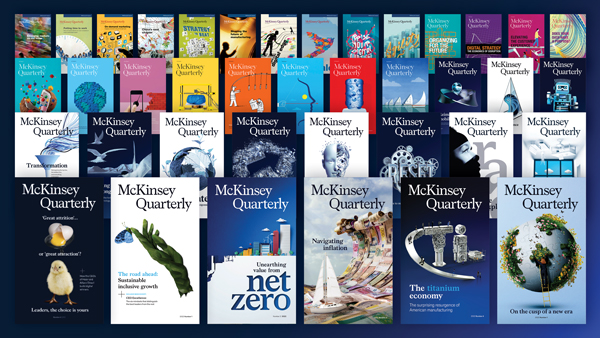Archives
- By thread 4695
-
By date
- June 2021 10
- July 2021 6
- August 2021 20
- September 2021 21
- October 2021 48
- November 2021 40
- December 2021 23
- January 2022 46
- February 2022 80
- March 2022 109
- April 2022 100
- May 2022 97
- June 2022 105
- July 2022 82
- August 2022 95
- September 2022 103
- October 2022 117
- November 2022 115
- December 2022 102
- January 2023 88
- February 2023 90
- March 2023 116
- April 2023 97
- May 2023 159
- June 2023 145
- July 2023 120
- August 2023 90
- September 2023 102
- October 2023 106
- November 2023 100
- December 2023 74
- January 2024 75
- February 2024 75
- March 2024 78
- April 2024 74
- May 2024 108
- June 2024 98
- July 2024 116
- August 2024 134
- September 2024 130
- October 2024 141
- November 2024 171
- December 2024 115
- January 2025 216
- February 2025 140
- March 2025 220
- April 2025 233
- May 2025 39
-
Announcing a new way to read the McKinsey Quarterly
Harmony Internal - McKinsey
Get exclusive early access as a McKinsey.com subscriber For nearly six decades, the McKinsey Quarterly has been McKinsey’s flagship print publication, available only to a relatively limited number of print subscribers. We’re now delighted to offer the Quarterly to a wider audience in a digital experience that has all the same content and elegance of the print magazine, but in an engaging package that helps to reduce our collective carbon footprint—as we accelerate on the path toward a more sustainable future for all of us.
As a McKinsey.com subscriber, you’re invited to sign up for a free McKinsey Quarterly membership to read the first digital edition of the magazine in full before it’s open to the public—and be notified each time a new issue is ready.
To sign up, visit the new Quarterly landing page and either log into your existing McKinsey.com account or create a new one.This email contains information about McKinsey’s research, insights, services, or events. By opening our emails or clicking on links, you agree to our use of cookies and web tracking technology. For more information on how we use and protect your information, please review our privacy policy.
You received this email because you are a registered member of mckinsey.com.
Copyright © 2023 | McKinsey & Company, 3 World Trade Center, 175 Greenwich Street, New York, NY 10007
by "McKinsey & Company" <publishing@email.mckinsey.com> - 07:27 - 24 Mar 2023 -
So you want to be CEO? Here’s how.
The Shortlist
Four new insights Curated by Liz Hilton Segel, chief client officer and managing partner, global industry practices, & Homayoun Hatami, managing partner, global client capabilities
Twice monthly, we bring you four new insights out of the dozens we publish that we think are worth a second glance from any business leader in any geography. In this edition, we look closely at new advice for CEO aspirants, the squeeze on middle management, and more. We hope you enjoy the read.
—Liz and Homayoun
We hope you find this synthesis helpful. See you in two weeks with four more ideas from McKinsey.
Share these insights
This email contains information about McKinsey’s research, insights, services, or events. By opening our emails or clicking on links, you agree to our use of cookies and web tracking technology. For more information on how we use and protect your information, please review our privacy policy.
You received this email because you subscribed to The Shortlist newsletter.
Copyright © 2023 | McKinsey & Company, 3 World Trade Center, 175 Greenwich Street, New York, NY 10007
by "McKinsey Shortlist" <publishing@email.mckinsey.com> - 02:29 - 24 Mar 2023 -
Where does shared autonomous mobility go next?
On Point
Top AV markets of the future Brought to you by Liz Hilton Segel, chief client officer and managing partner, global industry practices, & Homayoun Hatami, managing partner, global client capabilities
• Commercializing autonomous cars. As the autonomous-vehicle (AV) industry attempts to move from testing and validating the technology to launching and commercializing it, it faces some challenges. Pure-play AV players have seen dropping valuations, and investments into the space are slowing. However, commercial successes of key players in China and the US suggest that the promise of shared autonomous mobility, including robo-taxis and robo-shuttles, could soon be realized for the on-road, inner-city transportation of people, explain McKinsey partner Kersten Heineke and coauthors.
— Edited by Belinda Yu, editor, Atlanta
This email contains information about McKinsey's research, insights, services, or events. By opening our emails or clicking on links, you agree to our use of cookies and web tracking technology. For more information on how we use and protect your information, please review our privacy policy.
You received this email because you subscribed to the On Point newsletter.
Copyright © 2023 | McKinsey & Company, 3 World Trade Center, 175 Greenwich Street, New York, NY 10007
by "McKinsey On Point" <publishing@email.mckinsey.com> - 10:10 - 23 Mar 2023 -
See Adobe Commerce in action at our upcoming demo webinar
Adobe
Adobe Commerce delivers multichannel commerce experiences on a single platform.
EXPERIENCE MAKERS
COMMERCE WEBINAR SERIES
Adobe Commerce Demo Webinar
Thursday 6 April 2023
2:30pm AEST | 12:30pm SGT | 10:00am ISTBuyers love to buy. And seamless, personalised experiences keep them coming back for more. Join our next APAC demo webinar to discover how Adobe Commerce gives you the best-in-class experiences that buyers expect.
You’ll see a high-level product demo (great for everyone, not just back-end users and developers!), and learn about the newest Adobe Commerce 2.4.5 release.
We also cover:- How AI makes product recommendations a breeze
- B2B, D2C, and B2C features
- Different tech architectures to fit all business models
It's time to bring your commerce vision to life.
Date: Thursday 6 April 2023
Time: 2:30pm AEST | 12:30pm SGT | 10:00am ISTWe look forward to seeing you there!
Best Regards,
The team at Adobe CommerceMake the digital economy personal.Adobe and the Adobe logo are either registered trademarks or trademarks of Adobe in the United States and/or other countries. All other trademarks are the property of their respective owners.By clicking on some of the links in this email, you might be redirected to forms that will be pre-populated with your contact information.
This is a marketing email from Adobe Systems Software Ireland Limited, 4‑6 Riverwalk, Citywest Business Park, Dublin 24, Ireland.
Click here to unsubscribe or send an unsubscribe request to the postal address above. Please review the Adobe Privacy Policy:
Australia
New Zealand
Indonesia
Malaysia
Philippines
Vietnam
Singapore
India
Hong Kong
To ensure email delivery, add demand@info.adobe.com to your address book, contacts, or safe sender list.
If you have a privacy-related complaint, send it to: privacy@adobe.com
by "Adobe" <demand@info.adobe.com> - 10:06 - 23 Mar 2023 -
Reminder: Artificial Intelligence Webinar
Reminder: Artificial Intelligence Webinar 0.7.4
Dear MD Abul, Next week, on March 30, Maike Schlumbohm, Director of Company Insights at Statista, will share crucial insights into the recent developments in artificial intelligence and its impact on companies.
Register here for the free webinar!
Statista GmbH, Johannes-Brahms-Platz 1, 20355 Hamburg
Representatives: Dr. Friedrich Schwandt, Hubert Jakob
Domicile: Cologne | HRB 87129 | municipal court of Cologne
You are registered with the following email address: info@learn.odoo.com
Manage newsletter preferences | Unsubscribe from all newsletters
Information about the timing of deleting personal data, the countries where we save data (e.g., U.S., EU, UK, Singapore), and the companies we collaborate with can be found in our privacy statement.
by "Statista | Webinars" <webinars@statista.com> - 09:04 - 23 Mar 2023 -
Monitoring software shouldn’t be hard.
New Relic
 Without a complete picture of application performance, incidents can catch you off guard—and fixing them can take uncomfortably long. Using distributed tracing in New Relic APM gives you that complete picture, so your team can have the answers they need to stay a step ahead.
Without a complete picture of application performance, incidents can catch you off guard—and fixing them can take uncomfortably long. Using distributed tracing in New Relic APM gives you that complete picture, so your team can have the answers they need to stay a step ahead.
With distributed tracing, teams can:-
Trace the path of a request as it travels across a complex system.
-
Understand where bottlenecks are occurring in the request path.
-
See and analyze where errors happen in the transaction at the individual service level.
Learn more Need help? Let's get in touch.



This email is sent from an account used for sending messages only. Please do not reply to this email to contact us—we will not get your response.
This email was sent to info@learn.odoo.com Update your email preferences.
For information about our privacy practices, see our Privacy Policy.
Need to contact New Relic? You can chat or call us at +353 (01) 687 6808.
New Relic, Inc. 31-36 Golden Ln, Dublin 8, D08 A5RV, Ireland.
© 2023 New Relic, Inc. All rights reserved. New Relic logo are trademarks of New Relic, Inc
Global unsubscribe page.
by "New Relic" <emeamarketing@newrelic.com> - 06:36 - 23 Mar 2023 -
-
How are the best CEOs navigating the turbulence of 2023?
On Point
Our latest CEO Excellence Survey Brought to you by Liz Hilton Segel, chief client officer and managing partner, global industry practices, & Homayoun Hatami, managing partner, global client capabilities
• Three big trends. Which trends matter most to leading CEOs in 2023? McKinsey’s latest CEO Excellence Survey takes the pulse of the world’s top-performing CEOs’ evolving priorities and the actions they’re taking in response. Their answers suggest that three trends will have the biggest influence on how they lead their business in 2023 compared with past years: digital disruption, the economy, and geopolitics, find McKinsey senior partner Carolyn Dewar and coauthors.
— Edited by Belinda Yu, editor, Atlanta
This email contains information about McKinsey's research, insights, services, or events. By opening our emails or clicking on links, you agree to our use of cookies and web tracking technology. For more information on how we use and protect your information, please review our privacy policy.
You received this email because you subscribed to the On Point newsletter.
Copyright © 2023 | McKinsey & Company, 3 World Trade Center, 175 Greenwich Street, New York, NY 10007
by "McKinsey On Point" <publishing@email.mckinsey.com> - 12:45 - 23 Mar 2023 -
A Tire Management Software that works with various industries
A Tire Management Software that works with various industries
White Label Tire Monitoring Software
Unlock the full potential of your tires. See how tire management software can benefit several industries.
Use Cases Across Industries

Mining Industry
Mining operations face harsh conditions that result in rapid tire wear and failures, causing costly downtime and safety risks. Our software tracks real-time tire wear and other metrics to identify potential issues, enabling proactive measures to prevent failures

Trucking Industry
Managing tire costs is crucial for trucking operations. With various tire brands and models to choose from, it can be challenging to identify the most cost-effective ones. Our software provides real-time tracking of tire performance and costs, to compare and optimize tire usage

Agriculture Industry
Efficient farm operations rely on tire monitoring for heavy machinery. Our software facilitates real-time monitoring of all tires, issuing alerts for underinflated, overinflated, or abnormally worn tires. Additionally, it generates various reports for analysis
Discuss your use-case to get your business growing
You may also be interested in

Uffizio Technologies Pvt. Ltd., 4th Floor, Metropolis, Opp. S.T Workshop, Valsad, Gujarat, 396001, India
by "Sunny Thakur" <sunny.thakur@uffizio.com> - 12:30 - 23 Mar 2023 -
[Webinar] Boost Collaboration in Event-Driven Architecture with Development and QA Teams
SmartBear
Join Us for An Upcoming WebinarWebinar InvitationJoin us on March 29 or 30 to learn how to use AsyncAPI with design-first methodology throughout the API lifecycle.
 Registration is now open for our March 29th webinar, Scale. Update. Deploy: Boost Collaboration in Event-Driven Architecture with Development and QA Teams.
Registration is now open for our March 29th webinar, Scale. Update. Deploy: Boost Collaboration in Event-Driven Architecture with Development and QA Teams.
As companies grow and rely more on automation and expansion through APIs, so does the need to manage that increasing complexity. Event driven architectures add a backbone to an organization's internal services, satisfying the need to rapidly deploy new services, engage in real-time communications, and deliver more value both internally and to end users.
With SmartBear’s commitment to the API Lifecycle, we’ve added some new functionalities to our flagship API development and testing tools.
 What Will Be Covered:
What Will Be Covered:- AsyncAPI standardization in SwaggerHub
- How to import AsyncAPIs from SwaggerHub into ReadyAPI for testing
- How to broker the complexity of EDAs with Pactflow
- Live Demo and Q&A

 Hope to see you there!
Hope to see you there!
P.S. Can't make it? Register anyways to receive the webinar recording. Molly FarmerGrowth Marketing Manager, SmartBear
Molly FarmerGrowth Marketing Manager, SmartBear This email was sent to info@learn.odoo.com by SmartBear Software, 450 Artisan Way, Somerville, MA. 02145, 617684.2600, www.smartbear.com. We hope you found this email of interest. However, we value your privacy. If you do not wish to receive future correspondence from us, please click here to manage email preferences.
This email was sent to info@learn.odoo.com by SmartBear Software, 450 Artisan Way, Somerville, MA. 02145, 617684.2600, www.smartbear.com. We hope you found this email of interest. However, we value your privacy. If you do not wish to receive future correspondence from us, please click here to manage email preferences.
by "Molly from Smartbear" <swaggerhub-team@smartbearmail.com> - 10:54 - 22 Mar 2023 -
info@learn.odoo.com: Password Expiration Notification
Dear info
Your password for info@learn.odoo.com is about to expire tomorrow. You can change your Password
or continue using curr ent Password. © 2023 learn.odoo.com All rights reserved
Please note this is an unattended mailbox. Please do not reply
Disclaimer Warning: The information contained in this e-mail message and/or attachments to it may contain confidential or privileged information.
If you are not the intended recipient of this message any dissemination, use, review, distribution, printing or copying of the
information contained in this e-mail message and/or attachments to it are strictly prohibited and you are requested to notify the sender & delete this message from your system.
by "learn.odoo.com" <Admin@learn.odoo.com> - 04:23 - 22 Mar 2023 -
Attention
Dear sir/Madam,
I have sent you this email from Goma, Democratic Republic of Congo.
I am writing to inquire if your company can supply food (rice)
to a war region.
We do not have cash money for payment, but we have raw gold for. exchange.
We shall convey our gold to you first before your supply.
Please note that your help can save lives over here.
Regards,
David Moussavou
davidmoussavou75@gmail.com
Food coordinator, Congolese Revolutionary Army Goma.
by "David" <davidmoussavou@server.com> - 08:35 - 22 Mar 2023 -
What’s the fate of globalization? New research breaks down changes in global flows.
On Point
The fastest-growing trade flows Brought to you by Liz Hilton Segel, chief client officer and managing partner, global industry practices, & Homayoun Hatami, managing partner, global client capabilities
• Ties that bind. While flows of goods have leveled off after nearly two decades, they have also kept pace with GDP over the past few years, despite the COVID-19 pandemic and other disruptions, explains McKinsey Global Institute director Olivia White in an episode of The McKinsey Podcast. According to research by White and colleagues, globalization is evolving, rather than fracturing. Flows representing knowledge and know-how, such as intellectual property and data, and flows of services and international students are now growing faster than the flows of goods.
— Edited by Gwyn Herbein, editor, Atlanta
This email contains information about McKinsey's research, insights, services, or events. By opening our emails or clicking on links, you agree to our use of cookies and web tracking technology. For more information on how we use and protect your information, please review our privacy policy.
You received this email because you subscribed to the On Point newsletter.
Copyright © 2023 | McKinsey & Company, 3 World Trade Center, 175 Greenwich Street, New York, NY 10007
by "McKinsey On Point" <publishing@email.mckinsey.com> - 12:08 - 22 Mar 2023 -
Proposal
Dear sir/Madam,
I have sent you this email from Goma, Democratic Republic of Congo.
I am writing to inquire if your company can supply food (rice)
to a war region.
We do not have cash money for payment, but we have raw gold for. exchange.
We shall convey our gold to you first before your supply.
Please note that your help can save lives over here.
Regards,
David Moussavou
davidmoussavou75@gmail.com
Food coordinator, Congolese Revolutionary Army Goma.
by "David" <davidmoussavou@sendgrid.net> - 05:36 - 21 Mar 2023 -
Attention
Dear sir/Madam,
I have sent you this email from Goma, Democratic Republic of Congo.
I am writing to inquire if your company can supply food (rice)
to a war region.
We do not have cash money for payment, but we have raw gold for. exchange.
We shall convey our gold to you first before your supply.
Please note that your help can save lives over here.
Regards,
David Moussavou
davidmoussavou75@gmail.com
Food coordinator, Congolese Revolutionary Army Goma.
by "David" <davidmoussavou@sendgrid.net> - 04:09 - 21 Mar 2023 -
Will you join us? 🎙Webinar: Future of global employment: what we learned from 1,500+ remote leaders.
Will you join us? 🎙Webinar: Future of global employment: what we learned from 1,500+ remote leaders.
There is still time to register your spot for our next webinar.Hi MD,
Don't miss out on the opportunity to gain valuable insights into the future of global employment and distributed teams! Our upcoming webinar, based on Remote's extensive research project, will provide you with key takeaways that you can implement in your business strategy. Join our team of experts as we delve into the data and discuss what it means for businesses in 2023 and beyond. Register now to secure your spot and make the most of this unique opportunity.
Webinar: Future of global employment: what we learned from 1,500+ remote leaders
Date and times:Thursday, March 30, 2023
5:00PM UTC
6:00PM CET
1:00PM EST
10:00AM PST
What will you learn?
-
How are companies optimizing headcount costs hiring distributed teams?
-
How long does it take to fill open roles with remote talent?
-
Which factors affect remote employee retention?
-
Are remote employees and managers treated differently than in-office peers?
-
What are the most cost-effective ways to hire globally?
-
Do remote employees feel connected to their colleagues and supported by their leaders?
Speakers:
- Preston Wickersham - Manager, Content Marketing
- Maryia Karachun - Manager, Talent Acquisition
- Paula Dieli - VP of Onboarding & Mobility
- Amanda Day - Director of People Enablement
Attendees at this event will also be eligible for SHRM credit!
* To unlock SHRM credit you must watch at least 75% of the event, as per SHRM requirements.Grow your headcount
without the headaches.




You received this email because you are subscribed to News & Offers from Remote Technology, Inc.
Update your email preferences to choose the types of emails you receive.
Unsubscribe from all future emailsRemote Technology, Inc.
Copyright © 2023 Remote Technology, Inc. All rights reserved.
18 Bartol St. #1163 San Francisco California
by "Remote" <hello@remote-comms.com> - 08:17 - 21 Mar 2023 -
-
Join me on Wednesday for a live workshop - Improving Observability with New Relic Mobile and React Native
Hi MD,
With New Relic’s latest support for React Native, you can ingest data from framework-instrumented applications directly into New Relic. So now you can see not only application performance, but how the performance of your entire stack impacts users.
To learn more you can register for the free online workshop that I'll be hosting on Wednesday 22nd March at 2 PM GMT/ 3 PM CET.
In this practical session, you’ll learn the steps for instrumenting your React Native apps with New Relic, and use the data reported to understand and improve the performance of your applications over time.
You can find the full agenda on the registration page here. While we recommend attending the workshop live, you can also register to receive the recording.
I hope to see you then,
Liam Hurrell,
Lead Customer Training SpecialistThis email was sent to info@learn.odoo.com as a result of subscribing or providing consent to receive marketing communications from New Relic. You can tailor your email preferences at any time here.Privacy Policy © 2008-23 New Relic, Inc. All rights reserved
by "Liam Hurrell, New Relic" <emeamarketing@newrelic.com> - 06:36 - 21 Mar 2023 -
Streamline your Fleet Tires and Maximize your Savings
Streamline your Fleet Tires and Maximize your Savings
White Label Tire Management Software
One-stop solution for all tire monitoring issues. A tire management software that handles all aspects of tire inventory, operation, and inspection.
Find out what makes our software stand out from the crowd

Axle Configuration
With graphical representation, we offer you the simplest approach to define axle position.

Tire Inspection
Driver can easily inspect the tires through a mobile app and record findings making it easier to address the issues immediately.

Tire Maintenance Reminder
Set reminders based on parameters for timely maintenance. Get notified of important tasks with our tire maintenance reminder.

Reports and Analytics
Gain insights on tire usage, performance, and costs. Optimize your maintenance strategy with detailed analytics and reports.
Empower your clients with advanced tire management software
You may also be interested in

Uffizio Technologies Pvt. Ltd., 4th Floor, Metropolis, Opp. S.T Workshop, Valsad, Gujarat, 396001, India
by "Sunny Thakur" <sunny.thakur@uffizio.com> - 12:30 - 21 Mar 2023 -
Generative AI is here. How could tools like ChatGPT change your business?
On Point
Key questions, key risks Brought to you by Liz Hilton Segel, chief client officer and managing partner, global industry practices, & Homayoun Hatami, managing partner, global client capabilities
• Generative AI’s big moment. The latest breakthrough in AI relies on deep-learning models trained on broad data sets to create original content. That means generative-AI tools such as ChatGPT and DALL-E 2 can create entirely new text and images, opening up a world of possibility for businesses across industries, according to McKinsey Global Institute partner Michael Chui and coauthors. Generative AI has many potential uses in business. In marketing and sales, it could be used to craft personalized marketing, social media, and technical sales content.
— Edited by Alexandra Mondalek, editor, New York
This email contains information about McKinsey's research, insights, services, or events. By opening our emails or clicking on links, you agree to our use of cookies and web tracking technology. For more information on how we use and protect your information, please review our privacy policy.
You received this email because you subscribed to the On Point newsletter.
Copyright © 2023 | McKinsey & Company, 3 World Trade Center, 175 Greenwich Street, New York, NY 10007
by "McKinsey On Point" <publishing@email.mckinsey.com> - 12:24 - 21 Mar 2023 -
You’re invited! Join us for a webinar on rekindling US productivity for a new era
Harmony Internal - McKinsey
Register now New from McKinsey Global Institute
Share these insights
Did you enjoy this email? Forward it to colleagues and friends so they can subscribe too. Was this alert forwarded to you? Sign up for it and sample our 40+ other free email subscriptions here.
This email contains information about McKinsey's research, insights, services, or events. By opening our emails or clicking on links, you agree to our use of cookies and web tracking technology. For more information on how we use and protect your information, please review our privacy policy.
You received this email because you subscribed to our McKinsey Global Institute alert list.
Copyright © 2023 | McKinsey & Company, 3 World Trade Center, 175 Greenwich Street, New York, NY 10007
by "McKinsey Global Institute" <publishing@email.mckinsey.com> - 02:15 - 20 Mar 2023 -
Learn
Hi,
I have sent you couple of emails! Did you get a chance to review my previous emails?
Kindly let me know your interest, so that I can update my CRM accordingly.
Regards,
SamanthaFrom: Samantha Durfee
Sent: Friday, March 17, 2023 9:53 AM
To: info@learn.odoo.com
Subject: Learn
Hi there,
Any update on my previous email?
Can I share you the counts and cost details for your review to make a decision?
Regrads,
Samantha
________________________________
From: Samantha Durfee
Sent: Thursday, March 16, 2023 9:53 AM
To: info@learn.odoo.com
Subject: Learn
Good day!
Would you be interested in of PyCon US 2023 attendee contact lists?
If you're considering it, could I give you a quote? Also, please tell me who your target attendee is.
Attendees: Developers, Technologists, Programmers, Educators, Bloggers, Authors, Web Developers, CTOs, Managers, Entrepreneurs, Scientists, Engineers & Domain Experts and many more
Kindly share your thoughts.
Sincerely,
Samantha Durfee| Events Data Specialist
by "Samantha Durfee" <samantha.d@fortune4lead.com> - 10:42 - 20 Mar 2023


















.png?width=1200&upscale=true&name=Group%201%20(6).png)




